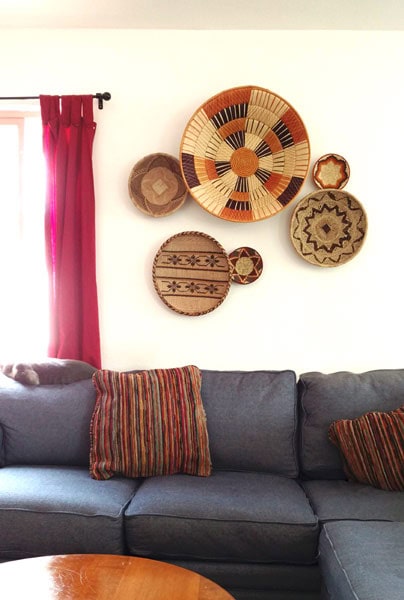No products in the cart.
Decorating with African Baskets
How to hang baskets on a wall

African baskets look amazing when they are mounted on a wall, like this display created by ChicvilleUSA.com.
But how do you hang a basket on a wall?
Here are some tips to help you get started with Baskets of Africa’s best-selling wall décor.
1) Most baskets are light enough to hang with a small nail and some fishing line. I use “Multi-Purpose Line” that is supposed to be able to handle up to 15 lbs.
2) Hold your basket up to a light to see where the fishing line can be fed through.


3) Create a loop in the fishing line near the center of the basket so that it will lay flat on the wall.
Both ChicvilleUSA and HGTV mention using nails driven through the center of baskets to hang them. This would be faster and easier, but it would also damage most baskets and be noticeable from close up.

Each type of basket will be different:
Winnowing baskets, like Binga and Gokwe baskets from Zimbabwe, are some of the most popular kinds of baskets to hang. They are relatively flat, very lightweight, and have a loose weave, so even the largest baskets are a breeze to hang.
Shallow bowls from Botswana have a smooth surface because they are very tightly stitched. To hang a Botswana basket, feed the fishing line through several of the stitches that cover the coils, then tie the fishing line into a loop.
Chivi baskets from Zimbabwe feature starburst patterns that look amazing on a wall – but they also have very thick, heavy coils. Distribute the weight of the basket by feeding the fishing line through several of the twine stitches before creating a loop.
Sisal bowls from Rwanda come with a loop on the back, so they come to you ready to hang… Ta-da!
Rwenzori bowls from southern Uganda are colorful, geometric, and smooth. They are lightweight, but have a tight weave, so to create a loop you will need to feed fishing line work from the front of the basket. Using needle-nosed tweezers, carefully push the line between the coils to the back of the basket (see photos).



Bukedo & Raffia baskets from Uganda are one of the most popular baskets to use for wall décor. HGTV Magazine featured a grouping of these baskets in a beautiful overlapping composition. Most Bukedo & Raffia baskets come with a loop woven into the back of the basket for hanging. These are heavier baskets, though, so we recommend using a more secure picture hook instead of just a nail. I have a big, beautiful, heavy, 23-inch Uganda basket. To hang it I used a big hook from the hardware store, making sure the hook went into the stud of my wall. The basket hangs above my sofa, so I wanted it to withstand any accidental bumps from my kid, my cat, or my guests.
My wall of baskets is a work in progress; there is room to grow. I would love to add some Mini Botswana bowls. They are about 6.75″ wide, and the warm colors and linear designs would be different than the patterns I have so far. But the texture of the Botswana baskets is what I love. They are intricately woven, so the surface is smooth, but the materials are earthier and less “polished” than the Rwenzori bowls.
I really had fun with this project. It surprises me how different the living room feels now that the baskets are up.
Explore Baskets of Africa’s collection, and have fun creating your own display!
By Anne Steen